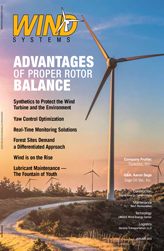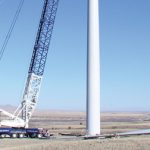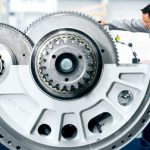Everyone is familiar with the problems associated with poorly balanced rotating equipment. When buying new tires for a car, you would not think of having them installed without first having them balanced. An unbalanced tire creates vibration forces that can be felt throughout the entire vehicle. A balanced tire is created when a small weight is placed opposite the “heavy spot” on the tire. This small weight is the difference between a bouncy, dangerous ride and a smooth one. The same can be said about a rotor on a wind turbine. A wind turbine rotor that is not balanced creates vibration forces that affect the mechanical life and operating performance of a turbine. Therefore, an acceptable level of wind turbine rotor balance should be established and measured as a part of any in-situ blade repair, blade replacement, wind turbine commissioning, end-of-warranty inspection, or reliability centered maintenance program. Figure
Problems Caused by Unbalanced Turbine Rotor
An unbalanced wind turbine rotor results from a mismatched weight distribution of the individual blades that make up the rotor. There may be several consequences of an unbalanced rotor on a wind turbine.
First, in light winds, a turbine may have trouble coming on line or may be operating in portions of the revolution as motor rather than a generator, both leading to potential loss of revenue for the wind farm operator. An unbalanced rotor accelerates and decelerates during each revolution. The turbine experiences loss of power during half of the rotor rotation and gain of power during the second half of rotation. The controller sees this as a satisfactory condition to stay connected. The solution is to properly balance the rotor. However, achieving a precision balance on a wind turbine rotor is easier said than done and falls outside of the skill set of most wind farm maintenance personnel as well as those who are specifically employed by general industry to balance rotating equipment.
Secondly, a wind turbine with an unbalanced rotor will lose some of its low wind production capability. For any given level of unbalance, it requires power to rotate it at a given shaft speed. This power requirement robs the rotor of speed for a given wind velocity and delays its synchronization with the utility. Consequently, it will require more wind velocity to achieve synchronization as compared with a balanced rotor. Again, an unbalanced rotor results in a loss of revenue potential for a wind farm operator which could have been realized otherwise by an acceptably balanced wind turbine rotor.
Third, the out of balance rotor continuously applies fluctuating loads to all of the mechanical components of a wind turbine (e.g. main shaft, main bearings, gear box, drive train support structure, yaw system, tower, bolts and even the foundation). In order to visualize the effect of the unbalanced force on a rotor, remember the unbalanced ceiling fan that operates on high speed and wobbles uncontrollably. If there wasn’t a flexible mounting to the ceiling, these forces would eventually cause the ceiling fan to fall as was the case when the flexible mount was not an installation requirement. The rotor weight of a ceiling fan is on the order of ten’s of pounds. The rotor weight of a wind turbine can be greater than 72,000 lbs. However, there is no flexible mounting for the wind turbine rotor. The mechanical structures which support the rotor are designed to keep the rotor in a fixed location. These constantly fluctuating loads add to the fatigue loading and shorten the mechanical life of these systems. Remember, fatigue life is finite. When you use it up through these wildly fluctuating loads, it’s gone. You unknowingly spend fatigue life on an unbalanced rotor which could have otherwise been spent on producing revenue. Premature expenses and loss of production will be incurred by the wind farm operator through the replacement of a major component or entire system as a result of this fatigue failure.
Rotor unbalance is a leading contributor to the need for frequent and costly maintenance action on yaw systems and fastening hardware. The unbalanced force on the rotor causes a reaction on the yaw system twice per revolution, accelerating the wear on the yaw gear teeth through impact loading and adding to the fatigue loading of the tower shell and mounting bolts. Yaw brakes are used to limit this impacting on the gears. However, the brakes do nothing to limit the loads transferred to the tower. For perspective, a typical turbine will have over 100 million of these “two per revolution” loading events in its life. That’s a lot of pounding and stressing on your machine components.
Causes of Wind Turbine Rotor Unbalance
Rotor unbalance results from an unmatched weight distribution between each of the blades on a rotor. Each blade on a hub produces a moment or a torque on the main shaft. The moment or torque can be represented as a weight mounted on a weightless arm at some distance from the centerline of rotation (main shaft). Ideally, the moments of each blade on the rotor are equal around the center of rotation. When these moments are identical, there is no net unbalance force on the rotor. The moment of a blade is the product of the distance of its center of gravity to the center of rotation and its total blade weight (see Figure 1).
It is for this reason that efforts are made to match the blades as closely as possible during blade manufacture.
Any changes which affect the weight distribution of the blade will affect the moment of a blade and, consequently, the balance quality of the rotor. Significant changes in blade moment can result from everything from manufacturing to blade repair. Examples of issues leading to blade repair are: structural cracking, gel coat cracking, lightning damage, gun shot damage, shipping damage, storage damage, ultraviolet environmental degradation, etc. Changes in blade moment may also happen during “normal” operation. Examples that produce changes in weight distribution and total blade weight are: oil and grease from pitch systems, wind erosion, water absorption, internal debris accumulation from poor construction, animals/nests from unprotected ground storage. Examples which produce unequal blade moments at time of manufacture are: poor production techniques, weak construction process controls, inconsistent manufacturing tools, etc. Over the twenty-year design lifespan of a wind turbine, there is a high probability that a wind turbine rotor will be operating with a higher degree of unbalance than desired — caused by any combination of these factors. Perhaps most concerning is that without good analysis, an operator may never know the extent of your balance problems.
Balance Quality
The international ISO 1940-1 standard is a widely accepted standard for selecting rigid rotor balance quality. It effectively grades and describes acceptable limits of rotor unbalance as a function of its rotating mass and rotational speed.
The lower the grade number, the better the rotor is balanced. For example, an ISO balance quality G0.4 would apply to a spindle of a precision grinder while an ISO G1600 would apply to the crankshaft of a large two-cycle, rigidly mounted engine. While a rotor balance quality standard has not been adopted by the wind turbine industry, an ISO G16 or better may prove to be a practical and acceptable target. G0.4 is achievable with tight blade manufacturing tolerances and/or dynamic field balancing.
The chart above is an adaptation of the ISO 1940-1 standard for the area of wind turbine rotor operation. To use the chart above, you would select the desired balance quality and the maximum operating speed of the wind turbine rotor. At the point where the operating speed intersects the desired balance quality line, find the corresponding value of “e” on the y-axis. Multiplying this value of “e” by the total weight of the rotor will give you the maximum amount of residual rotor unbalance allowed for the desired ISO balance quality. For example, if a rotor weighed 5,000 lbs and was operating at 60 rpm, for a G16 balance quality, it could have no more than approximately 500 in-lbs of residual unbalance. This is equivalent to one blade having an “extra” weight of 2 lbs located 250 inches away from center of the hub.
Rotor Balance — Static Blade Balancing
All three blades must create the same moment around the center of rotation when mounted on a wind turbine hub. This is accomplished by weighing the blades and then adding calculated weights such that each blade exhibits the same moment around the center of rotation. The inherent assumption is that if the blades are balanced, the assembled wind turbine rotor will be balanced. There is a phrase for those who ASSUME.
A generally accepted balancing practice for a blade repair shop or for field determination of blade balance requires weighing the tip and root ends of each blade through the use of flexible straps supporting the blade at prescribed distances and a crane weighing scale. Root and tip weights are then matched to the heaviest root and tip measurements by adding the appropriate amount of weight. This process makes the total blade weights the same and the moments of the roots and tips the same around the center line of rotation. Statically balancing the blades in this fashion will produce equal blade moments. However, it does so with more weight than is necessary. It will not only effectively increase the mass of the rotor more than required but will place additional bending fatigue on the blade as this corrective weight at the tip has to be supported against gravity every half revolution of the rotor. This extra weight is operationally counter-productive. Figure 2
Dynamic Rotor Balancing
For general industry, rotating equipment (fans, pumps, gears, motors, etc.) can be balanced using a transducer (displacement, velocity, acceleration) and a shaft reference to measure the response of the shaft supporting structure or the shaft itself to the unbalance forces in relationship to a physical location on the shaft. The rotational speed of general industry equipment is typically above 600 rpm. The process involves recording the amplitude response, typically with an accelerometer, at the turning speed (1X rpm) of the rotor and its relationship to a physical shaft reference. A trial weight is then added to the rotating object and the new 1X rpm amplitude response and shaft reference relationship is measured. By knowing the response to the trial weight, a corrective weight solution can then be calculated to nullify the unbalance.
This same principle can apply to wind turbine rotors and several companies offer corrective balancing of wind turbine rotors using this method. However, employing this method for wind turbine rotors is risky at best. The typical speed of a wind turbine rotor is below 60 rpm or 1 Hz and falls into a range of limited usable sensitivity for most standard transducers and associated data acquisition equipment. The reduction in sensitivity will necessarily limit the level of balance quality which can be achieved. The accessibility of the main shaft, where the 1X rpm amplitude response is measured, presents an issue as it may be elevated off of the ground by distances as great as 300 feet. Safety protocol may prevent personnel from being in this area during operation. Data acquisition is further complicated by the presence of non-steady wind and spurious structural responses which may limit data collection to periods of low wind. While several companies may balance a turbine rotor with this method, a simple assessment or validation of rotor balance using these methods may be cost prohibitive. As compared with static blade and static rotor balancing, a better rotor balance quality can be achieved dynamically within the limits of the traditional balancing instrumentation employed, technician skill level, and other factors.
Frontier Pro Services utilizes Dynamic PowerPro Balance™, a patented method and instrumentation to dynamically assess the degree of wind turbine rotor unbalance and provide for a corrective solution. This proprietary method does not employ the traditional sensors used in balancing and is not subject to the inherent sensitivity limitations. The technology performs throughout the motoring and generation range of the turbine. Furthermore, this technology allows both cost effective assessment and correction unattainable by traditional methods. As such, balance quality can be assessed and realized as a part of any in-situ blade repair, wind turbine commissioning, end-of-warranty inspection, or reliability-centered maintenance (RCM) program. The balance assessment can be made without any installation of trial weights and does not require turbine down time. While Frontier Pro Services targets to achieve a balance quality of G16, the utilization of this technology, as well as the process of installing the corrective weights internally to the blade, has enabled final balance qualities of G0.4.
Conclusion
Wind turbines are highly engineered mechanical devices designed to have balanced rotors. Unacceptable levels of rotor unbalance accelerate mechanical fatigue on everything connected to it — bearings, shafts, pitch systems, gearboxes, generators, yaw drives, towers, and even foundations. This excessive fatigue loading will cause performance issues on start up and shut down. Unbalanced rotors result from manufacturing, blade repairs, or blade alterations as well as events which can occur during operation. There is no debate; the cost of accelerated mechanical wear, delayed startup, and wind turbine motoring are real. Like a silent cash register, your costs accumulate on every sub-optimal turbine, every day. Precision rotor balancing can drastically reduce the continuous profit drain on your operation.
While static blade balancing is designed to achieve a balanced rotor, it will not achieve the objective due to measurement and process errors. Additionally, static blade balancing requires that the blades be removed from the rotor, which is expensive, time consuming, and risky. Traditional dynamic balance assessment and correction doesn’t provide the precision necessary to get optimal results. Thus, the best way to assure peak performance is to utilize Frontier Pro Services’ Dynamic PowerPro Balance system. As a part of overall reliability and performance management of a wind farm, establishing acceptability criteria for rotor balance is essential for blade repair, wind turbine commissioning, end-of-warranty inspection, or reliability-centered maintenance program. Management of rotor balance quality can now be cost effectively realized through the services and technology of Frontier Pro Services.








































